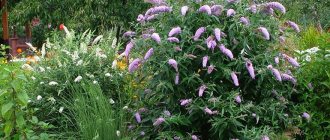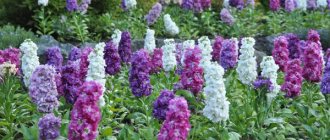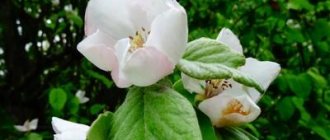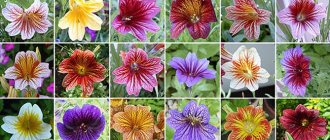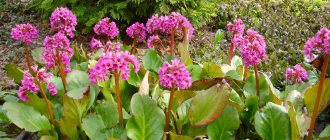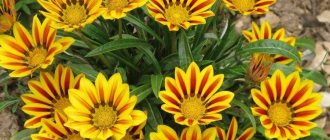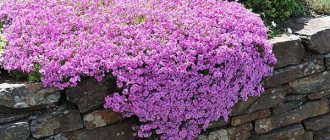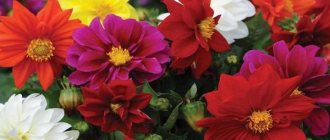Review author: Terrari School of Design
Dicentra is a plant covered in romantic legends and tales thanks to its heart-shaped flowers. Translated from Latin, its name means “double-spurred”. In the photo you can see how in the middle of the flowers there are small elongated processes resembling spurs.
This is a tall herbaceous plant of the Poppy family. The leaves are dissected and resemble feathers. The flowers are small in size, about two centimeters, in yellow, red, pink and white shades. The root of the dicentra is strong and strong.
The bush grows up to 80 cm in height. The inflorescences are arched, drooping, strewn with small flowers. After flowering, brown seed boxes are formed.
Landing
Dicentra is a shade-tolerant plant. In bright sun, its leaves can burn. Therefore, the place for planting the plant should be semi-shaded.
Dicentra is planted in open ground in spring in May or autumn in September. But when planting in autumn, you need to take into account the climatic features of the region. In the middle zone and northern latitudes, the plant may not have time to adapt to a new place before the cold weather and may die.
Dicentra prefers loose, well-drained soils.
Site preparation includes certain stages of work.
- Dig a 40X40 hole.
- Crushed stone and broken bricks are laid at the bottom.
- The soil is mixed with river sand in half and humus is added (up to 3 kg per square meter). You can prepare humus yourself in advance using compost.
- If the soil is acidic, the reaction is neutralized with dolomite flour.
- The soil is watered with diluted nitrogen fertilizers a couple of days before planting.
Seedlings must be planted keeping a distance of about half a meter. After planting, the plant is watered abundantly.
How to plant correctly in open ground
In its natural distribution area, the bush grows under the protection of other trees . And this must be kept in mind when planting it on the site. A bright space with partial shade is perfect for this. Unlike the constantly scorching sun, glancing rays are not a problem. But systematic exposure to an open area can cause sunburn and wilting.
Plant bushes in places protected from strong winds and early frosts . These may be the outskirts of gardens, where the center is protected from the wind by other trees. It is recommended to plant a bush near buildings on the north or east side.
Care
After planting, the dicentra requires simple care, which consists of timely watering and loosening the soil. Heavy loams negatively affect its growth and development.
Watering should not be excessive; dicentra does not tolerate waterlogging. It is worth increasing the amount of water only during hot, dry weather.
In spring, dicentra needs nitrogen fertilizers. They help her gain weight and produce shoots. Urea gives a good effect. During flowering, the plant needs to be fed with complex fertilizers, for example, nitroammophos.
In the fall, before preparing for the winter period, it is customary to mulch the root zone with dry manure and sawdust. This will allow the plant to successfully withstand the cold and prepare the soil for the next spring season.
Dicentra responds well to fertilization with mullein infusion. This requires:
- mix manure and water in proportions 1:3;
- cover with a lid and let ferment;
- leave to infuse in a dark place for 10 days;
- Mix a liter of the resulting concentrate with 10 liters of water.
The plant needs to be watered with this infusion every 10 days during active growth and flowering. Organic compounds from liquid mullein are absorbed by the plant much better, and it pleases the eye with lush flowering longer.
What does the dicentra flower (broken heart) look like and where does it grow?
The birthplace of the flowering plant is a country with unusually beautiful nature. Dicentra is no exception. The bush appeared in Europe in 1816. Due to the original shape of the inflorescence, a large number of names have been coined for the plant:
- Broken heart;
- Dvushporets;
- Jeannette's heart.
The buds look like small split hearts. The plant adorned the gardens of noble families, the upper classes and the aristocracy. Gradually it expanded its possessions and began to appear almost everywhere. The hearts are so bright that it is impossible not to notice them on the site. Breeders, assessing the popularity of the species, began to make their own changes, created new varieties, adding new characteristics to the name:
- Exceptional;
- Gorgeous;
- Excellent;
- Graceful.
The variety requires special attention to its planting site. This is not only due to the peculiarities of the formation of the bush, but also the flowering of the bush. Pristine natural originality is so difficult to depict that it is better to see it in photographs or video scenes.
Reproduction and transplantation
The plant does not need frequent replanting. In one place, the dicentra grows safely for 6 years. After this time, it is recommended to dig up the plant and carefully divide the overgrown roots into 3-4 plots. Each should have 4-5 growing shoots. Reproduction by division is the simplest and most convenient way.
The plant tolerates it well, provided that the required number of active buds is maintained on the seedling. It is recommended to plant the dicentra in this way in May, until the bush reaches a large size.
Roots can only be divided with a sterile, sharp instrument to avoid infection of the plant. After the procedure, the knife should be thoroughly treated with alcohol for further work. The cuts on the roots are sprinkled with wood ash. If the plots are small in size, you can plant two of them in one hole at once.
Dicentra can also be propagated through seeds. They are collected in September. Seeds should be stored in a cool, dark place. They begin to sow them at home in containers in March. A month later the first shoots appear.
When the dicentra seedlings grow two full leaves, they are transplanted into open ground. The difficulty in germinating seeds lies in the low percentage of seedlings. In addition, such plants bloom only after two years.
Diseases and pests
Dicentra is quite resistant to diseases. If overwatered, it can develop tobacco spot and powdery mildew. Spots and stripes appear on its leaves, and the flower withers. For treatment, a solution of Bordeaux mixture is used.
Sometimes the dicentra is attacked by aphids. It can be seen on the underside of the leaf and on the trunk of the plant. To destroy the pest, anti-tlin is used.
Preparing for winter
The magnificent Alba dicentra, like other perennial crop varieties, must be covered with a layer of peat or humus for the winter. This will help prevent the top of the roots from freezing out if there is not enough snow.
You need to remove the shelter in early spring, without waiting for stable heat. During this period, if there is a threat of return frosts, it is better to use agrofibre to preserve young shoots.
It is important to know! Dicentra, planting and caring for the crop does not require any special skills, so any novice gardener can cope with it.
Varieties
Dicentra eximia
A large spreading bush up to 80 cm tall. This is the most common variety of dicentra among amateur gardeners. Unpretentious, frost-resistant, characterized by lush flowering. The leaves are pinnately dissected with three or two ends. It blooms throughout the month from May to June.
The photo shows the most famous varieties of di and “Valentina”. Alba has small white flowers. Her greens have a beautiful rich grassy color. Valentina is a very bright, memorable variety with dark green foliage and bright red heart-shaped flowers.
Beautiful Dicentra (Dicentra formosa)
A low-growing plant up to 30 cm high. The inflorescences consist of a scattering of small (up to 2-3 mm) pink flowers collected on a peduncle 15 cm long. The feathery foliage is colored golden-light green.
The beautiful dicentra blooms all summer from May to September. In landscape design it is often used to decorate alpine slides.
Dicentra cuccularia
A small plant from the eastern United States. The round, dissected leaves form small pads about 20 cm high. The peduncle is about 15 cm long. The flowers are white with long spurs.
Dicentra chrysantha
A tall plant reaching one and a half meters in height. Mexico is considered to be the birthplace of Dicentra auretoflora. She is thermophilic and does not tolerate winter well. Blooms for a long time. The flowers are bright yellow with two curved petals.
general information
It is believed that the birthplace of dicentra is Japan, but it has been cultivated all over the world for many years. Depending on the variety, there are annual and perennial varieties. But they all differ in the same original inflorescences.
Dicentra grows up to 1 m and develops a very powerful root system that goes deep into the ground. The most common shades are all variations of white, pink and crimson. Surprisingly, dicentra is a poppy plant. Herbaceous stems are straight or branched, with complex bluish leaves.
Photo: u-mama.ru
